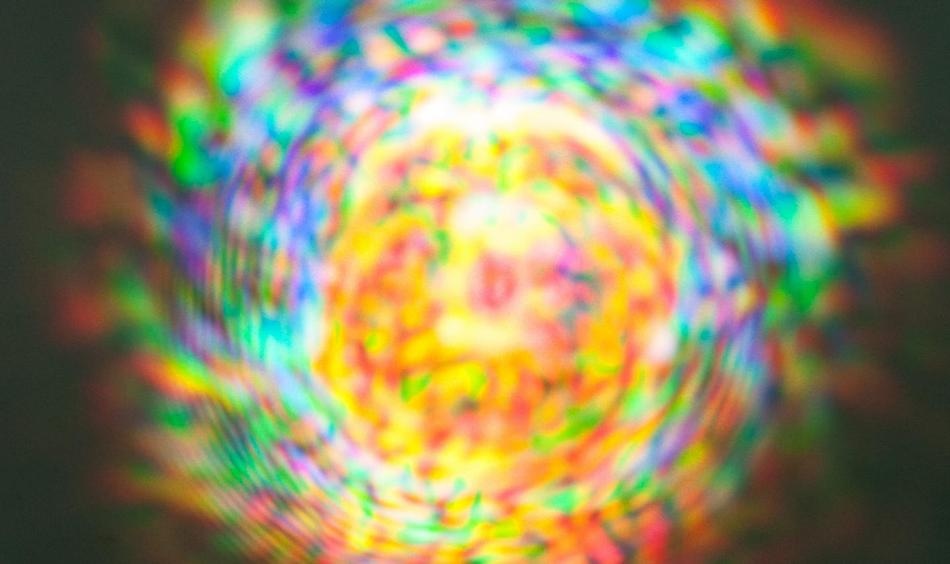Jun 22 2017
A system for recording holograms of minute objects such as living cells at femtosecond speeds has been developed by Scientists at the ITMO University. The innovative technique enables the phase topography of a sample under study to be reconstructed with respect to deformations emerging when a laser pulse passes through the sample.
 The iridescent picture indicates the occurrence of a spark known as a filament. CREDIT: ITMO University.
The iridescent picture indicates the occurrence of a spark known as a filament. CREDIT: ITMO University.
In contrast to electron microscopes, the device has the ability to visualize transparent biological structures without the need for using contrast agents. The outcomes of the study have been reported in a paper published in the journal Applied Physics Letters.
Essential activities of living cells are a complex series of physical processes and biochemical reactions, most of which occur at high temporal resolution. Highly precise and relatively faster equipment is required to record such rapid transformations. Although biological tissue can be analyzed by means of an electron microscope, the technique mandates the introduction of a distinctive dye into the sample, which introduces contrast to the cells, apart from having an impact on their metabolism. While digital holographic microscopes can overcome this disadvantage, they have a low spatial resolution.
The innovative camera developed by ITMO Researchers can register fast processes in transparent samples and allows one to increase the resolution of images in a wide range.. The equipment registers phase deformations of ultrashort (i.e. femtosecond) laser pulses that appear as light passes through the specimen under study. The phase images (i.e. holograms) will assist in analyzing the cells for in-depth knowledge on the mechanisms behind oncological, autoimmune and neurodegenerative diseases, as well as for observing cells at the time of surgical procedures such as cancer therapy.
Our device will help biologists and genetic engineers track what is happening inside a living cell with a resolution of about 50 femtoseconds—this is enough to resolve many biochemical reactions. Theoretically, the camera can even capture an electron jumping to another orbit. However, that is important, now we can study viability of cells not passively, but when initiating certain processes. For example, heating or transferring viruses, cells and its structures in three-dimensional space using femtosecond laser radiation. The device also supports tracking cell states during changing pH, adding and editing of genetic material.
Arseny Chipegin, Researcher, Laboratory of Digital and Display Holography, ITMO University
The analysis involves splitting a femtosecond laser beam into three beams, where the first beam ‒ with 95% energy ‒ initiates the process and the other two beams are applied for diagnostic purposes. The second beam, or the object beam, passes through the sample. The third, known as the reference beam, gets deflected by mirrors and travels around. The rays again interact at the back of the specimen to form an interference pattern of bright bands. The strips are formed if light wave crests overlap and amplify one another.
The Researchers delayed the reference beam by calibrating the position of the mirrors, thereby forcing it to interact with the first beam at disparate times. The second, known as object beam, passes through the specimen. Every collision of the beams are recorded on a subhologram, where all the subholograms are compiled as a sequence by a fast computer algorithm.
The Research team used a special glass including submicron inclusions and a spark generated by focusing an intense laser pulse as experimental objects. In both instances, they were able to swiftly acquire images with high quality and high temporal and spatial resolution.
The new equipment eliminates a significant drawback of digital holographic microscopy related to increasing resolution capability of a system at the hologram recording stage.
Technically, we can scale the images dozens of times, setting the magnifying system between the object and the camera. Not only does this enhance resolution, the measurement accuracy grows, too, since the number of interference bands does not change while they visually thin in comparison to the sample. Thus, it is possible to calculate the phase difference between the object and reference beams more precisely.
Nikolai Petrov, Head of the Laboratory of Digital and Display Holography
The objective of the Researchers is to further the study as the new system is designed such that it is very simple when compared to modern microscopes, and is advantageous with respect to hologram recording and processing speed.